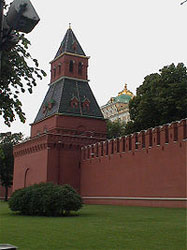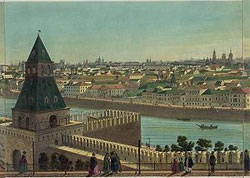
The Third Kremlin Clock Tower
/ Главная / Russkiy Mir Foundation / Publications / The Third Kremlin Clock TowerThe Third Kremlin Clock Tower
On July 19, 1425, the Italian architect Anton Fryazin (Antonio Gislardi) laid the first stone of the Tainitskaya Tower on the south wall of the Moscow Kremlin.

Aesthetically, the tower is quite effective. It is the oldest of the towers standing today, and its creation marked the beginning of the transformation of the Kremlin from the white-wall fortress of Dmitry Donskoy to the one we see today, similar to a the Castello Sforzesco in Milan. And there is strange in this similarity, as practically all of the architects invited to Moscow by Ivan III were Italians. And an Italian at that time in Russian were called Fryazin, which is why Anton(io) is referred to as such in Russian history books.
It is difficult to believe that at that time the Tainitskaya Tower was one of the most important in the Kremlin. It guarded, together with a second tower, the lowest point in the fortress walls. And it faces the river, the most dangerous of sides, as potential enemies were expected primarily from the south. The tower incorporated well reinforced gates surrounded by an archery perch. The tower was also one of the first to be capped with a roof similar to the ones typical of the Kremlin today.

Today few are aware of the fact that the Tainitskaya Tower, along with Spasskaya and Troitskaya towers, included chiming clock, albeit a small one. The chore of minding the clocks was not considering a prestigious one back in those days, and the archives contain a multitude of complaints from the clock winders. The complaints are familiar ones: years go by without getting paid, no money is allocated to repair the clock mechanisms, the roof is in disrepair… The clock was later dismantled, along with the archery perch, and never restored.
Seven decades after it completion, the Tainitskaya Tower was completely dismantled to make room for the planned Kremlin palace. However, the government couldn’t find enough money to implement that project and the tower was rebuilt in it former form. However, the rebuilt tower was destroyed by the French when they occupied Moscow in 1812. The tower we see today is the third version, rebuilt during the reconstruction of the city after the war.
In 1860, once again according to the designs of an Italian architect, the archery perch was restored. But this time cannon artillery was installed, and they for many years (as in St. Petersburg) were fired every day at noon.
In the early 1930s the cannons were removed as was the archery perch, and to this day the Tainitsky Garden near the tower remains off limits to the general public…
New publications

 Mikhail Kalatozov, a director who transformed the world of cinematography in many ways, was born 120 years ago. He was a Soviet film official and a propagandist. Above all, he was capable of producing movies that struck viewers with their power and poetic language.
Mikhail Kalatozov, a director who transformed the world of cinematography in many ways, was born 120 years ago. He was a Soviet film official and a propagandist. Above all, he was capable of producing movies that struck viewers with their power and poetic language.  Ukrainian authorities have launched a persecution campaign against the canonical Ukrainian Orthodox Church (UOC), the biggest one in the country's modern history. Over the past year, state sanctions were imposed on clergy representatives, searches were conducted in churches, clergymen were arrested, criminal cases were initiated, the activity of the UOC was banned in various regions of the country, and monasteries and churches were seized.
Ukrainian authorities have launched a persecution campaign against the canonical Ukrainian Orthodox Church (UOC), the biggest one in the country's modern history. Over the past year, state sanctions were imposed on clergy representatives, searches were conducted in churches, clergymen were arrested, criminal cases were initiated, the activity of the UOC was banned in various regions of the country, and monasteries and churches were seized.  When Nektary Kotlyaroff, a fourth-generation Russian Australian and founder of the Russian Orthodox Choir in Sydney, first visited Russia, the first person he spoke to was a cab driver at the airport. Having heard that Nektariy's ancestors left Russia more than 100 years ago, the driver was astonished, "How come you haven't forgotten the Russian language?" Nektary Kotlyaroff repeated his answer in an interview with the Russkiy Mir. His affinity to the Orthodox Church (many of his ancestors and relatives were priests) and the traditions of a large Russian family brought from Russia helped him to preserve the Russian language.
When Nektary Kotlyaroff, a fourth-generation Russian Australian and founder of the Russian Orthodox Choir in Sydney, first visited Russia, the first person he spoke to was a cab driver at the airport. Having heard that Nektariy's ancestors left Russia more than 100 years ago, the driver was astonished, "How come you haven't forgotten the Russian language?" Nektary Kotlyaroff repeated his answer in an interview with the Russkiy Mir. His affinity to the Orthodox Church (many of his ancestors and relatives were priests) and the traditions of a large Russian family brought from Russia helped him to preserve the Russian language.

 The leaders of the Friends of the Great Russia cultural association (Amici Della Grande Russia) in Italy believe that the Western policy of abolishing Russian culture in Europe has finally failed. Furthermore, it was doomed to failure from the beginning.
The leaders of the Friends of the Great Russia cultural association (Amici Della Grande Russia) in Italy believe that the Western policy of abolishing Russian culture in Europe has finally failed. Furthermore, it was doomed to failure from the beginning.  Name of Vladimir Nemirovich-Danchenko is inscribed in the history of Russian theater along with Konstantin Stanislavski, the other founding father of the Moscow Art Theater. Nevertheless, Mr. Nemirovich-Danchenko was a renowned writer, playwright, and theater teacher even before their famous meeting in the Slavic Bazaar restaurant. Furthermore, it was Mr. Nemirovich-Danchenko who came up with the idea of establishing a new "people's" theater believing that the theater could become a "department of public education."
Name of Vladimir Nemirovich-Danchenko is inscribed in the history of Russian theater along with Konstantin Stanislavski, the other founding father of the Moscow Art Theater. Nevertheless, Mr. Nemirovich-Danchenko was a renowned writer, playwright, and theater teacher even before their famous meeting in the Slavic Bazaar restaurant. Furthermore, it was Mr. Nemirovich-Danchenko who came up with the idea of establishing a new "people's" theater believing that the theater could become a "department of public education."  "Russia is a thing of which the intellect cannot conceive..." by Fyodor Tyutchev are famous among Russians at least. December marks the 220th anniversary of the poet's birth. Yet, he never considered poetry to be his life's mission and was preoccupied with matters of a global scale. Mr.Tyutchev fought his war focusing on relations between Russia and the West, the origins of mutual misunderstanding, and the origins of Russophobia. When you read his works today, it feels as though he saw things coming in a crystal ball...
"Russia is a thing of which the intellect cannot conceive..." by Fyodor Tyutchev are famous among Russians at least. December marks the 220th anniversary of the poet's birth. Yet, he never considered poetry to be his life's mission and was preoccupied with matters of a global scale. Mr.Tyutchev fought his war focusing on relations between Russia and the West, the origins of mutual misunderstanding, and the origins of Russophobia. When you read his works today, it feels as though he saw things coming in a crystal ball...